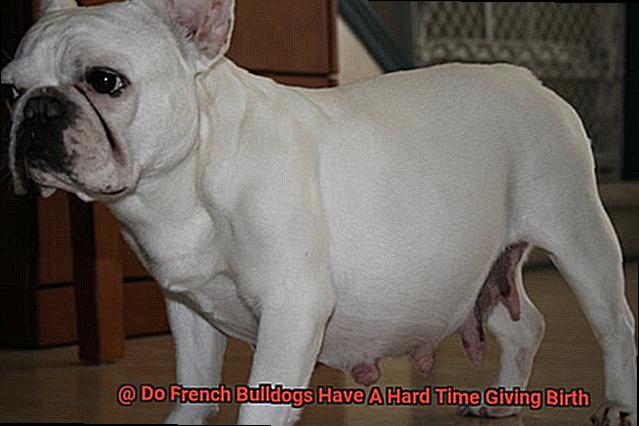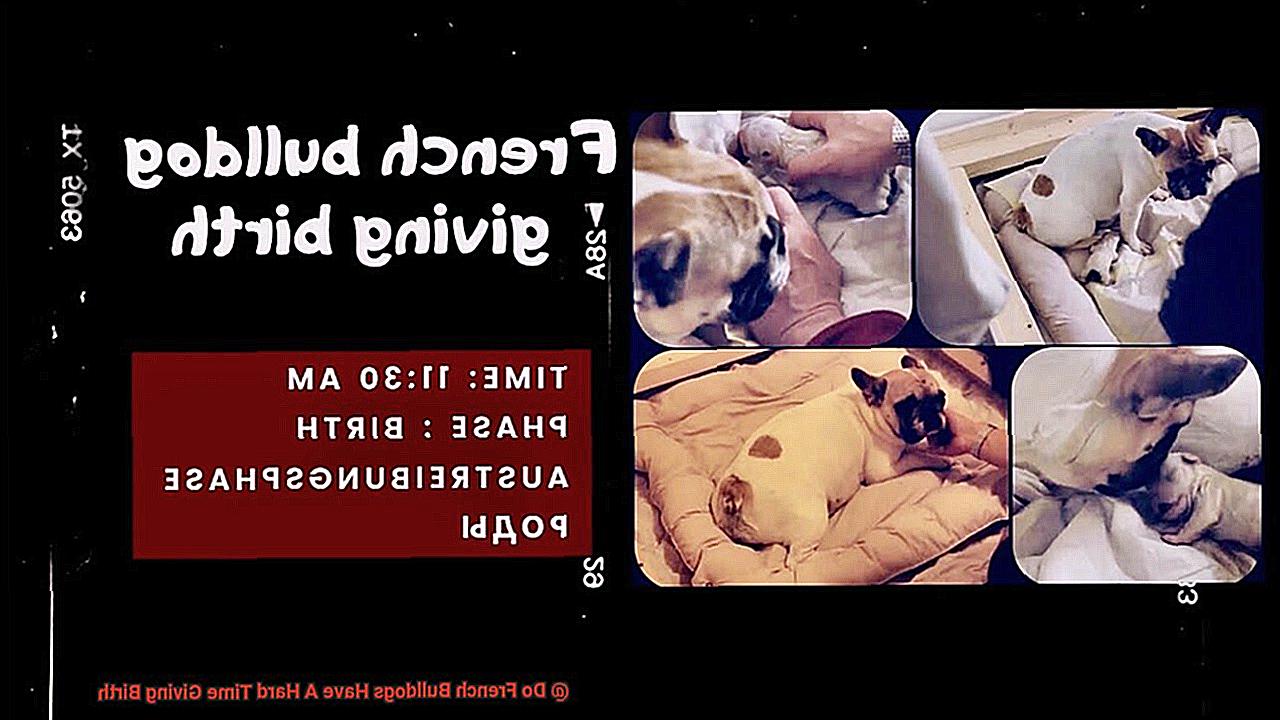Do French Bulldogs Have A Hard Time Giving Birth?
Picture those cute, bat-like ears and those irresistible snorts – it’s no wonder French Bulldogs have become such popular family pets. But behind their adorable facade, there’s a challenge that often goes unnoticed: childbirth. Curiosity about the prevalence of delivery complications among Frenchies is piqued among both current and aspiring owners. In this blog post, we dive into the world of French Bulldog pregnancies, exploring the hurdles these lovable canines face as they bring new life into the world. Get ready to uncover truths, debunk myths, and shed light on the birthing dilemma that French Bulldogs encounter.
The Anatomy of French Bulldogs and How it Affects Birthing
Contents
- 1 The Anatomy of French Bulldogs and How it Affects Birthing
- 2 The Narrow Birth Canal of French Bulldogs
- 3 The Larger Head Size of French Bulldog Puppies
- 4 The Tendency for Large Litters in French Bulldogs
- 5 Health Conditions that Can Complicate Birthing in French Bulldogs
- 6 Monitoring the Mother During Labor and Delivery
- 7 Cesarean Sections for French Bulldogs
- 7.1 The Narrow Birth Canal: A Tight Squeeze
- 7.2 Prolonged Labor and Distress: The Need for Speed
- 7.3 Complications Detected During Pregnancy: Anchoring Down for Safety
- 7.4 Collaborating with an Experienced Veterinarian: Charting a Course for Success
- 7.5 The C-Section Procedure: Sailing Through Safe Delivery
- 7.6 Smooth Sailing in Recovery: Nurturing Mother and Puppies Alike
- 8 Pre-Breeding Care to Minimize Difficulties During Birthing
- 9 Conclusion
In this blog post, we’re going to dive into the fascinating world of French Bulldog anatomy and how it can impact the birthing process. So, grab a cup of coffee and let’s get started.
The Brachycephalic Skull Shape:
French Bulldogs have a distinctive flat skull, giving them their cute and endearing appearance. However, this adorable feature can lead to narrow birth canals in female French Bulldogs. Imagine trying to squeeze through a tight space – it’s not exactly a walk in the park. The same goes for our furry friends during labor.
Small Pelvis:
Another factor that can add to the challenges of birthing in French Bulldogs is their small pelvis. The compact size of their pelvis restricts the space available for puppies to maneuver through during delivery. This can result in obstructed labor, where the puppies find it difficult to make their way out into the world.
Compact Size and Large Head:
French Bulldogs may be small in stature, but they sure do have big heads. This can pose a problem during the birthing process as the puppies’ heads need to pass through the narrow birth canal. The combination of their compact size and larger heads increases the difficulty of delivery for both the mother and the puppies.
Assistance During Labor:
Given these anatomical challenges, it’s not uncommon for French Bulldogs to require assistance during labor and delivery. Many French Bulldog moms undergo cesarean sections (C-sections) to ensure a safe and successful birth. So, if your Frenchie is expecting, be prepared for a trip to the vet for this potentially life-saving procedure.
Conclusion:
Understanding the unique anatomy of French Bulldogs is crucial for their owners, especially during the birthing process. It’s essential to work closely with your veterinarian, monitor your Frenchie’s health, and be prepared for potential challenges. By taking proactive steps and seeking professional assistance when needed, we can help our beloved French Bulldogs navigate the sometimes tricky journey of bringing new life into the world.
Remember, you’re not alone in this journey. Reach out to fellow Frenchie owners and share your experiences, tips, and support. Together, we can ensure a safe and successful birthing experience for both our furry friends and their adorable little puppies.
The Narrow Birth Canal of French Bulldogs
Today, we’re going to dive deep into the fascinating world of French Bulldog anatomy and uncover the hurdles these delightful pups face during the birthing process.
So, grab a cup of joe and join us as we explore the challenges these cuties encounter when it’s time to welcome a litter of adorable puppies.
The Skinny on the Narrow Birth Canal
One of the main difficulties French Bulldogs face during childbirth is their narrow birth canal. Unlike some other dog breeds, Frenchies have a petite pelvic opening, making it quite a challenge for those little pups to make their grand entrance into the world.
Blame It on Their Body Shape

It’s all about those unique physical characteristics that make French Bulldogs so irresistible. Their compact and muscular bodies, combined with a short and stocky build, can pose some serious challenges during labor and delivery. With their pelvis being on the smaller side, there’s limited space for those precious puppies to maneuver through.
The Perils of a Petite Pelvic Passage
When it’s time for childbirth, the puppies must navigate through that narrow birth canal to greet the world. Unfortunately, its narrowness can lead to a host of problems, such as prolonged labor, difficulty in pushing out the puppies, and even the need for medical intervention like cesarean sections.
Size Matters Too.
To add another layer of complexity to the mix, French Bulldogs often have larger heads in comparison to their body size. This disproportionate ratio can make it even more challenging for them to squeeze through that already tight birth canal.
Help from the Veterinary World
Given these anatomical limitations, it’s no surprise that Frenchies often require some extra assistance during labor and delivery. Many breeders and owners seek the support of experienced veterinarians or opt for planned cesarean sections to ensure a safe birthing process for both the mama and her adorable pups.
Taking Precautions
If you’re a proud French Bulldog owner or considering breeding your Frenchie, it’s crucial to be aware of these challenges. Regular check-ups with a veterinarian experienced in canine reproduction are essential to monitor the health and well-being of both the mother and her puppies.

In a nutshell, French Bulldogs face some real struggles when it comes to giving birth. Their unique physical characteristics, including a narrow birth canal and larger heads, add an extra layer of difficulty to the process. So, make sure to provide your Frenchie with the proper veterinary care and support needed for a safe and smooth delivery.
The Larger Head Size of French Bulldog Puppies
French Bulldogs are undeniably one of the most lovable dog breeds out there. With their compact bodies and flat faces, they have a unique and distinct appearance that captures the hearts of many.
However, one aspect of their anatomy that can cause complications during childbirth is the larger head size of French Bulldog puppies. Now, don’t worry, this isn’t meant to scare you.
We’re here to shed some light on this topic and provide you with the information you need to ensure a safe and healthy delivery for your beloved Frenchie.
What’s the Big Deal?
So, why is the larger head size of French Bulldog puppies something to be aware of? Well, it all comes down to the size discrepancy between their precious little noggins and the mother’s birth canal. You see, the average head circumference of a French Bulldog puppy is around 12 inches – not too shabby, right? But when compared to the narrow birth canal of the mother, it can pose some challenges.
Dystocia: The Not-So-Fun Side of Puppy Birth
The larger head size can lead to a condition called dystocia, which is just a fancy medical term for difficult or prolonged labor. It happens when those adorable little heads get stuck in the birth canal and can’t pass through naturally. And let me tell you, dystocia is no party for anyone involved – not for the mother and definitely not for the puppies. It can lead to oxygen deprivation for the pups, which can result in stillbirth or developmental issues. Yikes.
Blame It on History
To understand why French Bulldogs have a larger head size in the first place, we need to take a little trip back in time. French Bulldogs were actually bred from smaller English Bulldogs, who also had a knack for having trouble giving birth naturally because of their large heads. So, selective breeding was done to shrink the overall size of the breed and improve their birthing abilities. But, as luck would have it, the larger head size still persists in our beloved Frenchies.
Now that we know about the potential challenges associated with the larger head size of French Bulldog puppies, let’s talk about how we can navigate those challenges and ensure a safe delivery. First and foremost, regular prenatal check-ups with your veterinarian are an absolute must. These check-ups will allow your vet to monitor the pregnancy and make sure everything is progressing smoothly.
But wait, there’s more. X-rays may also be recommended closer to the due date to determine the number and size of the puppies, as well as assess any potential complications. This can give you a better idea of what you’re working with and help you prepare accordingly.
The Tendency for Large Litters in French Bulldogs
We all know that these little bundles of joy steal our hearts with their adorable appearance and friendly personalities. But did you know that French Bulldogs have a tendency for large litters? In this blog post, we’ll dive into the reasons behind this tendency and explore the implications it has on their birthing process. So, grab a cup of tea, sit back, and let’s get started.
The Tendency for Large Litters:
Unique Breeding History:
French Bulldogs have a fascinating breeding history that contributes to their tendency for large litters. They were created by mixing English Bulldogs with various terrier breeds, all in the pursuit of creating a smaller version of the Bulldog. This mix resulted in French Bulldogs inheriting some traits from their English Bulldog ancestors, including larger litter sizes.
The Small Package Factor:
French Bulldogs may be small in size, but they sure pack a punch when it comes to litter sizes. Their relatively small bodies mean limited space in the mother’s uterus for the puppies to develop. With less room to grow properly, complications during birth can arise.
Implications on the Birthing Process:
Labor Challenges:
Due to the size discrepancy between the mother’s birth canal and the puppies’ heads, French Bulldogs can face a condition called dystocia during labor. This condition can lead to stillbirth or developmental issues for the puppies. Regular prenatal check-ups with an experienced veterinarian can help identify any potential problems and ensure a safe delivery.
Veterinary Assistance:
In some cases, French Bulldogs may require veterinary assistance during labor to ensure a smooth delivery. This assistance may come in the form of a C-section, which is often recommended to avoid complications and ensure the safety of both the mother and her puppies.
Health Conditions that Can Complicate Birthing in French Bulldogs
French Bulldogs are adorable little companions known for their affectionate nature and charming personalities. However, their unique anatomy and genetic predispositions can make birthing a challenging process. In this section, we will explore the health conditions that can complicate birthing in French Bulldogs and how to navigate them for a safer delivery.
Brachycephalic Obstructive Airway Syndrome (BOAS):
French Bulldogs are brachycephalic, which means they have a short, flat face and a compressed airway. This adorable feature can unfortunately lead to respiratory difficulties, especially during physical exertion or times of stress. BOAS is a common condition in French Bulldogs and can further complicate the birthing process. The narrowed airways and elongated soft palate associated with BOAS can make breathing difficult for both the mother and her puppies during labor.

Narrow Birth Canal:
In addition to respiratory difficulties, French Bulldogs also have a narrow birth canal. This combination of factors can make natural delivery challenging for these dogs. Puppies may struggle to pass through the birth canal, leading to prolonged labor or even the need for a cesarean section. It is important for owners to be prepared for this possibility and work closely with their veterinarian to ensure a safe delivery for both the mother and her puppies.
Hip Dysplasia:
Hip dysplasia is a hereditary condition where the hip joint doesn’t develop properly, resulting in pain and mobility issues. This condition can make it difficult for the mother to assume the necessary positions for birthing and may require intervention from a veterinarian. Regular monitoring and appropriate management of hip dysplasia can help minimize complications during birth.
Obesity:
French Bulldogs are prone to obesity, which can increase the risk of complications during pregnancy and delivery. Excessive weight gain can make it harder for the mother to carry the puppies and may require medical assistance during birth. It is crucial for owners to ensure their French Bulldogs maintain a healthy weight throughout pregnancy to minimize potential complications.
Reproductive Disorders:
French Bulldogs are also susceptible to reproductive disorders such as pyometra (a uterine infection) or dystocia (difficult labor). These conditions can arise due to hormonal imbalances or anatomical abnormalities in the reproductive system, further complicating the birthing process. Regular check-ups and monitoring of the mother’s reproductive health can help identify and address these issues early on.
Monitoring the Mother During Labor and Delivery
However, it is crucial to monitor the mother during labor and delivery to ensure a safe and successful delivery for both her and her precious puppies. In this blog post, we will explore why monitoring the mother is essential and discuss various aspects of monitoring that can help guide owners through this process.
Monitoring Vital Signs:
- Heart rate, respiration rate, and blood pressure should be closely monitored using specialized equipment.
- These parameters can help identify any signs of distress or complications that may require immediate intervention.
- Regular monitoring ensures the mother’s overall health and well-being during labor and delivery.
Assessing Contractions:
- Monitoring the frequency and intensity of contractions helps determine the progress of labor.
- External tocodynamometers or palpation of the abdomen can provide valuable information about contractions.
- This allows veterinarians to identify potential difficulties or dystocia (difficulties in giving birth) early on.
Continuous Uterine Activity Monitoring:
- In some cases, continuous monitoring of uterine activity may be required.
- An intrauterine pressure catheter (IUPC) can be placed in the uterus to measure contractions directly.
- This method provides accurate information about the strength and duration of contractions, aiding in decision-making during delivery.
Managing Pain and Comfort:
- Painful contractions can cause distress and anxiety in the mother, affecting her ability to push effectively.
- Providing appropriate pain relief measures, such as analgesic medications or epidurals, promotes a smoother delivery process.
- Ensuring the mother’s comfort level is essential for a successful delivery.
Cesarean Sections for French Bulldogs
If you’re a proud owner of this adorable and lovable breed, you may already be familiar with some of the unique challenges they face when it comes to giving birth. French Bulldogs, with their brachycephalic (short and flat-skulled) features, can experience difficulties during labor and delivery. But fear not, for we are here to shed light on why Cesarean sections (C-sections) may be necessary for our beloved Frenchies.
The Narrow Birth Canal: A Tight Squeeze
Prolonged Labor and Distress: The Need for Speed
When a French Bulldog mother experiences prolonged labor or shows signs of distress, it’s time to take action, me hearties. Prolonged labor can put undue stress on both mother and puppies, increasing the risk of complications. A C-section can provide a safe and speedy delivery, ensuring the well-being of all involved.
Complications Detected During Pregnancy: Anchoring Down for Safety
Sometimes, during routine prenatal care or diagnostic tests, veterinarians may detect complications that could jeopardize the health of the mother or puppies. In such cases, a C-section is often recommended to minimize risks and ensure the best outcome for all.
Collaborating with an Experienced Veterinarian: Charting a Course for Success
When it comes to birthing French Bulldogs, savvy sailors seek the guidance of experienced veterinarians who specialize in this breed. These knowledgeable professionals can assess the mother’s health, evaluate the size and position of the puppies, and determine if a C-section is necessary.
The C-Section Procedure: Sailing Through Safe Delivery
During a C-section, the mother is under the care of skilled veterinarians who make a small incision in her abdomen and uterus to safely remove the puppies. The procedure is typically performed under general or epidural anesthesia, ensuring the mother’s comfort and safety.
Smooth Sailing in Recovery: Nurturing Mother and Puppies Alike

After a C-section, the mother requires special attention and care during her recovery period. Pain medication, antibiotics, and close monitoring are essential to ensure proper healing. Likewise, the puppies need vigilant observation for any signs of distress or health issues as they adjust to their new world.
Pre-Breeding Care to Minimize Difficulties During Birthing
Get ready to set sail on a journey to ensure a smooth and safe birthing process for your beloved French Bulldogs. As an expert in pre-breeding care to minimize potential birthing difficulties, I’m here to share with you the importance of taking proactive steps before breeding your French Bulldogs. By providing the right care and attention, we can navigate through the treacherous waters of dystocia and ensure the health and safety of both the mother and her precious puppies.
Check the Health of Both Parents:
Before embarking on the breeding journey, it’s crucial to ensure that both the male and female French Bulldogs are in good health. A thorough medical examination by a veterinarian specializing in reproductive health can help identify any underlying health conditions that could affect the birthing process.
Set Sail with Proper Nutrition:
Proper nutrition is vital for the mother during pregnancy. Feeding her a high-quality diet that meets her nutritional needs will help ensure the healthy development of the puppies and prepare her body for delivery. Consult with your veterinarian to determine the best diet for your furry friend.
Keep Her Fit for the Voyage:
Regular exercise is essential for maintaining the mother’s overall health and keeping her muscles toned. However, it’s important to avoid excessive exercise or activities that could strain her body during pregnancy. Take leisurely walks together instead of vigorous activities.
Chart the Course with Weight Monitoring:
Monitoring the mother’s weight gain throughout pregnancy is essential. Sudden or excessive weight gain could indicate potential complications, so it’s important to consult with a veterinarian if there are any concerns. Keep an eye on those pounds.

Create a Calm Haven:
Providing a calm and stress-free environment for your pregnant French Bulldog is crucial. Stress can have negative effects on her health and well-being, indirectly impacting the birthing process. Create a comfortable whelping area that’s warm, quiet, and secluded, providing her with a sense of security and privacy.
Prepare Your Birthing Kit:
Just like a seasoned sailor, you need to be prepared for any situation. Have a birthing kit ready in advance, including clean towels, sterile gloves, scissors, lubricant, and other necessary items that may be needed during the birthing process. Be the captain of readiness.
Know the Signs of Labor:
Educate yourself on the signs of labor and the stages of delivery. This knowledge will help you recognize any potential complications or signs that veterinary assistance may be required. Be the lookout for any distress signals.
Emergency Plan Ahoy:
Last but not least, have a plan in place in case of emergencies. Know the nearest emergency veterinary clinic and have their contact information readily available. This could be a lifesaver in critical situations.
Conclusion
French Bulldogs often face difficulties during the birthing process.
Their unique physical characteristics, such as their large heads and narrow hips, can make it challenging for them to deliver puppies naturally. The breed’s popularity has led to an increase in irresponsible breeding practices, which further exacerbates the problem.
It is crucial for potential owners to understand these risks and be prepared for the possibility of complications when considering breeding or adopting a French Bulldog.




